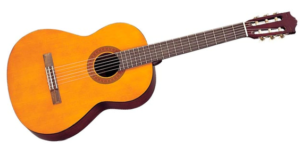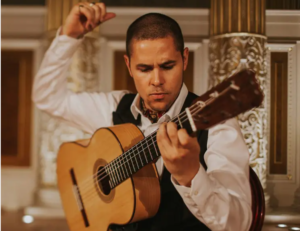Inside The Latin Guitar Course
Grant McDonald
November 2, 2021
 If you are interested in playing Latin guitar you have to take the guitar fundamentals course and all of the level 1 Modules. You have to learn how to play on the acoustic/classical guitar and learn the basics like chords, notes and scales. The time frame varies, but it usually take 6-18 months to be proficient or comfortable enough to play. This also includes finger-picking and strumming which requires a lot of practice.
If you are interested in playing Latin guitar you have to take the guitar fundamentals course and all of the level 1 Modules. You have to learn how to play on the acoustic/classical guitar and learn the basics like chords, notes and scales. The time frame varies, but it usually take 6-18 months to be proficient or comfortable enough to play. This also includes finger-picking and strumming which requires a lot of practice.
In general if you graduate the guitar fundamentals and level 1 modules course, it will take 26-32 months with regular practice or just over 2 years.
There are 4 techniques in Latin Guitar:
One of the worlds foremost Spanish flamenco player, Paco Pena (born in 1942) has as a guitarist, composer, producer and artistic mentor has made a great impact in this type of music (https://www.pacopena.com/)

Some of his techniques are:
- Finger picking
- Tirando Technique
- Tremolo Picking
- Rasqueado Technique
(Source: https://nationalguitaracademy.com/spanish-guitar-lessons/)
The latin Guitar course is open to graduates of the Guitar Fundamentals course as well as students of the intermediate and advanced course. The course will have 6 fundamentals modules and 6 advanced modules. In addition we will have up to 26 videos that can be accessed on line as long as you have internet access and a desktop and laptop computer or tablet. However, the videos are accessible if you signed up with a monthly learning package through a membership portal with password protection.
We also have in class lessons for students for up to 2 hours per day, but you must have proof of vaccination from COVID-19 for your safety and that of the instructor.
Since we have to keep up with Intergrated Services Digital Network (ISDN) technologies, Zoom video conference is available. Video conferencing will be available for all students regardless of the learning packages they signed up for on an individual or group conferencing. There is a cost to this service.
We will also at the discretion of the instructor place pdf files on google Drive for download (such as chords, songs, diagrams etc).
Breaking News
Grantsguitarlessons.com is in the process of developing a new course on teaching students how to play Bossa Nova which literally means “new wave,” was a blending of samba and jazz that rose out of a guitar school formed in Rio de Janeiro’s Copacabana neighborhood in 1956.
The goal is to have this course ready for the Fall of 2024.
Open ONLY to graduates of ANY Guitar Fundamentals Course
Stay tuned for updates
**Bossa Nova Guitar Course Outline**
Below is a suggested 11 week course outline
—
#### **Module 1: Introduction to Bossa Nova**
1. **History and Origins**
– Overview of Bossa Nova’s roots in Brazil.
– Key figures: João Gilberto, Antonio Carlos Jobim, Vinícius de Moraes.
2. **Characteristics of Bossa Nova**
– Rhythmic patterns.
– Harmonic structure.
– Melodic elements.
3. **Cultural Context**
– Socio-political background of the Bossa Nova movement.
– Influence of Samba and Jazz.
#### **Module 2: Basic Guitar Techniques**
1. **Guitar Setup and Tuning**
– Standard tuning.
– Proper posture and hand positioning.
2. **Basic Chords and Progressions**
– Major and minor chords.
– Basic progressions used in Bossa Nova.
3. **Strumming and Fingerstyle Techniques**
– Basic strumming patterns.
– Introduction to fingerstyle playing.
#### **Module 3: Introduction to Rhythm and Comping**
1. **Understanding Bossa Nova Rhythm Patterns**
– Classic Bossa Nova rhythm pattern.
– Variations of the rhythm.
2. **Right-Hand Techniques**
– Thumb and finger independence.
– Syncopation and groove.
3. **Left-Hand Techniques**
– Chord changes and transitions.
– Muting and percussive effects.
#### **Module 4: Essential Chords and Harmony**
1. **Extended Chords**
– 7th, 9th, 11th, and 13th chords.
– Understanding chord extensions and alterations.
2. **Chord Voicings and Inversions**
– Common voicings used in Bossa Nova.
– Playing inversions smoothly.
3. **Chord Progressions**
– II-V-I progressions.
– Common Bossa Nova progressions.
4. **Chord Substitution**
– Basics of chord substitution.
– Using substitutions to add variety.
#### **Module 5: Rhythmic Mastery**
1. **Advanced Bossa Nova Rhythm Patterns**
– Exploring less common rhythms.
– Integrating multiple rhythms.
2. **Polyrhythms and Syncopation**
– Understanding polyrhythms.
– Applying syncopation in Bossa Nova.
3. **Groove and Feel**
– Developing a strong groove.
– Emphasizing the feel of Bossa Nova.
#### **Module 6: Popular Bossa Nova Repertoire**
1. **”The Girl from Ipanema”**
– Chord progression and rhythm.
– Playing the melody.
2. **”Desafinado”**
– Harmonic structure.
– Rhythmic feel.
3. **”Wave”**
– Analysis of chords and melody.
– Integrating rhythm and harmony.
4. **Additional Songs**
– “Corcovado (Quiet Nights of Quiet Stars)”
– “Agua de Beber”
– “Chega de Saudade (No More Blues)”
#### **Module 7: Improvisation and Soloing**
1. **Melodic Phrasing**
– Creating melodic lines.
– Use of space and dynamics.
2. **Scales and Modes**
– Major and minor scales.
– Modes commonly used in Bossa Nova.
3. **Soloing Techniques**
– Connecting scales with chord tones.
– Developing solos over Bossa Nova progressions.
4. **Transcribing Solos**
– Learning solos by ear.
– Analyzing and understanding great solos.
#### **Module 8: Advanced Techniques and Concepts**
1. **Harmony and Counterpoint**
– Creating harmony in Bossa Nova.
– Counterpoint techniques.
2. **Arranging and Composing**
– Arranging Bossa Nova songs for guitar.
– Composing original Bossa Nova pieces.
3. **Advanced Chord Substitution and Extensions**
– Exploring more complex substitutions.
– Using upper extensions effectively.
#### **Module 9: Performance and Practice Tips**
1. **Practice Routines**
– Effective practice strategies.
– Time management for practice sessions.
2. **Playing with Other Musicians**
– Ensemble playing techniques.
– Communication in a band setting.
3. **Live Performance Tips**
– Overcoming performance anxiety.
– Engaging with the audience.
#### **Module 10: Exploring Bossa Nova Fusion**
1. **Bossa Nova and Jazz**
– Integration with jazz harmony and improvisation.
– Notable artists and recordings.
2. **Bossa Nova and Samba**
– Differences and similarities.
– Techniques for blending the styles.
3. **Modern Bossa Nova Interpretations**
– Contemporary artists and innovations.
– Incorporating modern elements.
#### **Module 11: Recording and Production Techniques**
1. **Recording Bossa Nova Guitar**
– Microphone placement and techniques.
– Capturing the authentic sound.
2. **Basic Production Skills**
– Using DAWs for Bossa Nova music.
– Mixing and mastering tips.
3. **Creating Backing Tracks**
– Producing play-along tracks.
– Using loops and samples effectively.
—
### **Additional Resources**
– **Recommended Listening**
– Playlist of essential Bossa Nova recordings.
– **Reading Materials**
– Books and articles on Bossa Nova history and theory.
– **Online Resources**
– Links to online tutorials and backing tracks.
By following this expanded course outline, students will gain a comprehensive and in-depth understanding of Bossa Nova guitar, covering both foundational and advanced topics.
Have Any Question?
Regardless of what learning package that you have signed up for, if you have any questions please dont hesitate to call Grant McDonald at:
- 416-529-7877
- grantman7160@gmail.com
Join Our Newsletter
Sign Up for our upcoming Monthly news letter that provides important information in guitar training education

Expert in teaching Acoustic and Electric Guitar for 20 years in Mississauga.
- Mississauga, Ontario Canada L5C-1A8
- grantman7160@gmail.com
- 416-529-7877
Work Hours
- 10AM - 6 PM , Monday - Friday, Closed Saturday and Sunday
Above is the schedule of our teaching hours each week!
Music School Template Kit Modified by Page Marketing
